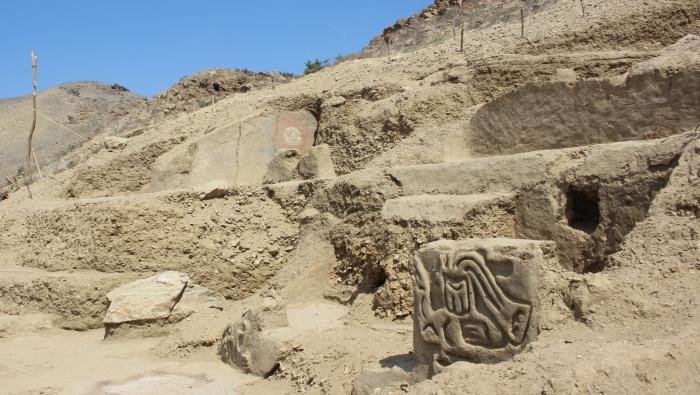Archaeologists in Peru have uncovered the ruins of a 5,000-year-old ceremonial temple and skeletal remains beneath a sand dune in the Zaña district of northwestern Peru. The site is part of the Los Paredones de la Otra Banda-Las Ánimas Archaeological Complex, according to a statement from the Peruvian Ministry of Culture.
 The 5,000-year-old temple found in northwestern Peru. Credit: DDC Lambayeque/Peru Ministry of Culture
The 5,000-year-old temple found in northwestern Peru. Credit: DDC Lambayeque/Peru Ministry of Culture
The excavation, which began on June 3, revealed the remnants of a multistory temple made from rammed earth. Dr. Luis Armando Muro Ynoñán, director of the Archaeological Project of Cultural Landscapes of Úcupe – Zaña Valley, described the site: “We are probably looking at a 5,000-year-old religious complex that is in an archaeological space defined by walls built of mud. We have what would have been a central staircase from which one would ascend to a kind of stage in the central part.”
The temple walls were decorated with intricate friezes depicting images of human bodies with bird heads, feline features, and reptilian claws. The upper portions of the walls were covered in fine plaster with pictorial designs. Researchers also found the remains of three adults between the walls, possibly part of sacrificial rituals, as the burials included ceremonial offerings wrapped in cloth. Dr. Muro noted that radio-carbon dating is still pending, but evidence suggests the construction aligns with a tradition of temples built on Peru’s northern coast during that period.
The temple’s staircase leading to a platform or stage indicates its significance in religious rituals. The anthropomorphized carvings on the temple walls, combining human and animal features, highlight the symbolic and artistic practices of the era.
Additionally, archaeologists unearthed another monument dating between CE 600 and 700, during the Moche period. The Moche, known for their human sacrifices, constructed large temples and created fine art, including ceramic goblets shaped like human heads. At this second unit, researchers discovered the burial of a child, estimated to be around five or six years old, indicating a later period burial than the three adults.
The Peruvian Ministry of Culture, through the Decentralized Directorate of Culture of Lambayeque, supervised and verified the progress of this research, funded by the Catholic University of Peru and the University of California, Los Angeles (UCLA). The aim is to study the emergence, evolution, and development of the ceremonial center and elite cemetery of La Otra Banda and Úcupe, which were significant between the Formative and Moche periods.
The discoveries add to the rich archaeological heritage of northern Peru, home to numerous ceremonial complexes such as the Sacred City of Caral. The temple at Los Paredones de la Otra Banda-Las Ánimas reveals that the sophisticated building techniques seen during the Inca civilization date back several millennia before the Incas.
Peru Ministry of Culture





